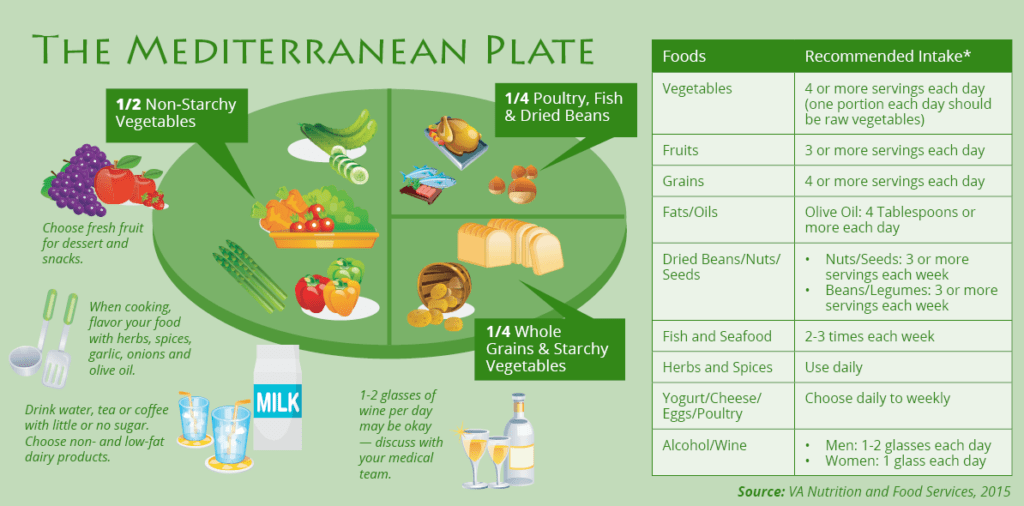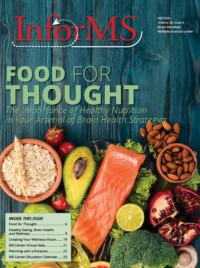A Conversation with Holly Sullivan, Registered Dietician and National Board Certified Health & Wellness Coach | To further explore the world of nutrition, healthy eating, and MS, we sat down (virtually) for a conversation with Holly Sullivan, RD, NBCHWC.
 Holly is a Registered Dietitian and National Board Certified Health and Wellness Coach who worked with the MS Wellness Pilot Program. Holly has experience working with people on nutrition for a variety of issues, ranging from general healthy eating to nutrition support for critical illness and just about everything in between. She currently works at the University of Colorado Hospital in the Pulmonary Rehabilitation, Cardiac Rehabilitation, and Using Diet in Epilepsy Therapy clinics. She enjoys each area of nutrition with the number one goal of patient success and overall positive outcomes.
Holly is a Registered Dietitian and National Board Certified Health and Wellness Coach who worked with the MS Wellness Pilot Program. Holly has experience working with people on nutrition for a variety of issues, ranging from general healthy eating to nutrition support for critical illness and just about everything in between. She currently works at the University of Colorado Hospital in the Pulmonary Rehabilitation, Cardiac Rehabilitation, and Using Diet in Epilepsy Therapy clinics. She enjoys each area of nutrition with the number one goal of patient success and overall positive outcomes.
InforMS: Could you please discuss the science behind healthy eating and brain health?
Sullivan: While no diet has been shown to cure or prevent MS, good nutrition can still have a positive impact on some symptoms and can lower the risk of developing other diseases and disorders. Eating a healthful, nutritious diet is also about optimizing your quality of life while managing your MS.
Your food is the fuel for your body and mind. If you fuel yourself with high-quality, nutrient dense foods, then your body and mind will function at their best.
On the other hand, if you fuel yourself with empty, low-nutrient foods like junk food, fast food, and soda, then your body and mind may have enough calories, but they will be lacking in actual nutrients like vitamins, minerals, and other beneficial compounds. We cannot dial everything in food down to a pill you can take. If you are not getting nutrients from real food, you will not be feeling or functioning at your best. Getting your nutrients from real food is key.
For people with MS, you are already dealing with damage caused by MS itself. It’s even more important to give your brain the best chance it has to compensate for this damage. If you are eating optimally, you are giving your brain the best chance to make some repairs. If you are eating junk food, you may be compounding the effects of MS.
InforMS: What does the research tell us about how healthy eating helps people living with MS?
Sullivan: We conducted a Wellness Pilot Program for people living with MS. The participants who improved their diet and lifestyle reported less fatigue and more energy. Research studies have shown similar results. A study conducted in 2018 and described in the journal Neurology, found that people who followed a healthy diet and lifestyle were less likely to have more disability.
InforMS: We know that layers of comorbidities — other health conditions — multiply bad health outcomes. When you have uncontrolled or badly controlled diabetes and MS, you will feel the ill effects of MS more than if diabetes was controlled. Could you talk about the importance of healthy eating for people in terms of preventing comorbidities?
Sullivan: There are a number of comorbidities that are common for people with MS including diabetes and heart disease. Studies show that individuals with more comorbidities may have more frequent MS relapses, more rapid progression of disease, higher levels of disability, increased lesion burden, and decreased brain volumes. These individuals may also be hospitalized more often.
So what’s the good news? This is something you can fight back against: You have control. A healthy diet and a healthy lifestyle can help to reduce disability, improve symptoms, and can help keep you from developing the comorbidities, like diabetes and heart disease. And if you already have one or more of these conditions, there is still a lot you can do to manage it with healthy choices. There are many things you can improve with diet and exercise.
InforMS: Could you please describe some of the diets that we hear about most?
Sullivan: There is not a specific diet that controls MS. However, there are a number of alternative diets that have been promoted for MS. A systematic review among dietary interventions in MS failed to confirm the benefits of the Swank and other alternative diets.
The Swank diet is a very stringent low fat diet. It avoids dairy, gluten, legumes, and virtually all saturated fats. Good results in Swank’s research study were reported, however the study was limited by various issues (absence of blindness, no control, and no randomization). Other researchers haven’t duplicated the results and there’s no generally accepted proof that the Swank diet really controls MS.
The Paleo diet is promoted by Dr. Terry Wahls. It recommends consuming non-domesticated, lean meats, and plant-based foods except fruits, nuts, roots and legumes, or gluten-containing grains. This diet also avoids eggs and dairy. Limitations of this diet include risk for nutritional deficiencies including folic acid, vitamin B1, vitamin B6, calcium, and vitamin D.
The McDougall diet is a very low-fat, plant-based, high-carbohydrate diet. One study found this diet reduced fatigue but did not show an effect on MS disease activity.
The bottom line at this point is that different diets have been suggested for MS, but none has been shown to be superior to others, and there’s no concrete evidence that a specific diet controls MS.
However, the diet we know most about and that can have some of the biggest benefits for all of us, especially if you are living with MS, is the Mediterranean diet.
InforMS: What is the Mediterranean diet? What are its benefits?
Sullivan: The Mediterranean diet is high in vegetables, fruits, whole grains, beans, nuts and seeds, and olive oil. The diet includes daily consumption of vegetables, fruits, whole grains, and healthy fats; weekly intake of fish, poultry, beans, and eggs; moderate portions of dairy products; and limited intake of red meat. Meals are built around plant-based foods.
For more information on the specifics of the Mediterranean diet, please see the chart and graphic above.
Studies have shown that the Mediterranean diet is protective against many of the most prevalent chronic diseases, including cardiovascular disease, cancer, Parkinson’s disease, Alzheimer’s disease and other cognitive decline, depression, and inflammation.
It’s also been linked to a longer lifespan. It is also an eating pattern recognized by the American Diabetes Association that can help people at risk for diabetes or who are living with diabetes.
It is one of the most studied diets from standpoints of overall health and reduction of common diseases.
InforMS: Especially during stressful times, many people often turn to food for comfort which doesn’t always lead to the healthiest choices. How do you help people navigate that dynamic in more balanced ways?
Sullivan: Food is often used as part of a coping mechanism. When we are stressed, the goal isn’t to pretend you aren’t stressed or that you don’t need comfort, but it’s about honoring your emotions and finding a healthy way to meet your needs. It’s helpful to pause, to take a step back, and ask yourself what you are feeling. Think about what emotions you are having and try to find a way to meet the need that you actually have at that moment. Am I feeling tired, or sad, or frustrated? What could help me cope with that emotion?
If you are frustrated, maybe call a friend to vent. If you are sad, maybe call your dog over and get some cuddles. If you’re bored, maybe you could start listening to an audiobook, or listen to a song you love, or start a new activity that you enjoy. If you’re angry, maybe you could find a private place and yell or punch a pillow. Although eating could make you feel better for the five to ten minutes that you’re actually eating, that feeling is quickly gone and you’re back to the emotion you started with. You absolutely deserve to have a way to let off some steam when you are stressed, but the best way to do so is if you can find a way that doesn’t just add more problems to your plate and to your overall well-being.
InforMS: How does eating a healthy diet help individuals stay more physically active?
Sullivan: These two healthy lifestyle components really go hand in hand. And, there’s not necessarily a wrong place to start. If you are eating more healthfully, you will have more energy, which will make it more likely you add some movement into your day, which will make you feel better, which may make it easier to get a healthy meal on the table, and so on. Some people start with improving their eating habits and gain the energy to add in more activity. On the other hand, some people start by working on increasing their activity, then start to see food as fuel for their activity, which helps them eat healthier. Instead of seeing food as an activity, it can be helpful to see it as fuel.
Sleep is another integral connection point for healthy eating. I worked with one dietician who counseled clients to start with sleep, and then build in physical activity, and then integrate healthy eating after that. Sleep is truly foundational. If you are sleep deprived, you are likely going to struggle to make the healthiest choices. Set aside time to get to bed earlier, get a solid night of sleep, wake up, and have more energy. If you’re feeling good and well-rested, you’re setting yourself up to make good choices throughout your day.
InforMS: As you know, fatigue is a very common symptom for people living with MS and studies show us that healthy lifestyle factors including how we move and what we eat can have an impact on fatigue levels. Could you please talk a bit about how blood sugar spikes can impact fatigue?
Sullivan: Eating candy, sweets or other refined carbohydrates, like white bread and white rice, can give you a quick blood sugar spike and a burst of energy. But that energy level quickly drops off and leaves you feeling tired and run-down. This is because when you eat those quick-energy foods, they are rapidly digested and absorbed, causing your blood sugar to act like a roller-coaster.
Your blood sugar spikes up initially, but then your body kicks into gear, releasing insulin in your system and dropping your blood sugar back down and making you feel an energy slump and like you need to take a nap. Eating balanced meals can help prevent this draining rollercoaster of blood sugar spike and drop. Balanced meals have protein, healthy fat, and complex carbohydrates. Eating balanced meals can help your body manage energy more effectively and can be one tool in your arsenal to combat MS fatigue.
InforMS: Could you please talk about sugar a bit more? Why is it so important to limit our sugar intake?
Sullivan: In a nutshell, sugar increases inflammation levels in the body. So, when you’re dealing with chronic conditions that increase inflammation levels, sugar can layer on to that problem. And the fact is that we’re all eating way too much sugar. Women should be eating less than 6 teaspoons of sugar per day and for men that amount is less than 9 teaspoons per day. Alarmingly, our average daily consumption is a whopping 22 teaspoons a day, and that is doing us some harm.
The tough part is that sugar is hiding in a lot of processed food that you wouldn’t necessarily expect. Let’s look at yogurt. In some popular flavored yogurts, there is almost 2 tablespoons of sugar in a single serving!
If you chose plain yogurt and add some fruit, you can still get the same overall taste but in a much healthier way.
InforMS: What about sugar in fruit?
Sullivan: When you are eating fruit or even milk, your body processes it differently than when it’s refined, added sugar. Fruit and milk have nutrients – there are vitamins and fiber in fruit and protein in milk. And your body responds to that kind of sugar differently.
InforMS: Do you find that incorporating meal planning is important for maintaining healthy eating habits? What strategies and tools do you find to be helpful?
Sullivan: With meal planning, there are options. You can go as simple or complex as you want. The key is thinking about how you are going to fill that healthy plate.
For me, I keep it simple. I grab a piece of paper, chart lines for each day of the week, and map out my veggie, my starch, and my protein for each meal. For people who want a more technology-rooted option, there are a few companies, such as E Meals or Eat Love where you can plug in how many calories and what nutrients you want and they will give you recipes that are portion sized tailored to you or your family. Based on your preferences, they kick out grocery lists to you or can even send those grocery lists directly to online grocery delivery services such as InstaCart. These services charge a monthly fee.
When you are planning meals, it’s always good to think about doubling the whole meal, so that you can eat for lunches during the week or freeze portions for the future. You can also think about doubling one thing. For example, you could double the grilled chicken you make for dinner. Then you can have enough for grilled chicken and veggies for lunch one day; grilled chicken over a salad the next day; and grilled chicken in a whole grain wrap with peppers and onion the next day.
InforMS: The Mediterranean diet includes an emphasis on whole grains. Let’s use the pizza example. How much benefit is there to opt for whole grain crust instead of the standard white flour pizza crust?
Sullivan: That choice definitely is going to be helpful. With whole grains, you have grains as they exist in nature: The outer fibrous part, the inner starchy part, and the germ, which is the more nutrient dense part. With refined grains, like white flour, the fibrous part and part of the germ has been removed. Only the starch remains, and that results in the unhealthy and energy-draining blood sugar spikes that we talked about before.
The beneficial fiber in whole grain foods helps regulate blood sugar by slowing down digestion of food. Starchy processed carbohydrates break down much more quickly than fiber-packed whole grain foods. So, if you’re eating whole grain pizza, it has a lower glycemic index than a white flour crust. Glycemic index is how quickly something spikes your blood sugar. The healthier whole grain option won’t cause your blood sugar to spike as quickly because the fiber helps to balance out the carbohydrate.
InforMS: So, if you love carbs and you feel like you can’t live without certain things like pasta or pizza or bread, a good way to make that healthier choice would be to switch those things to whole grain varieties?
Sullivan: Yes, that is a healthier alternative to incorporate. It’s also important to think about what you are pairing it with. So instead of carbs by themselves at meals or snacks, pair that whole grain bread with natural peanut butter. That way, you are balancing the carbohydrate with a protein.
InforMS: Intellectually, we understand that healthy eating is important. But, as we all know, the trick is incorporating that habit into our daily lives and sticking with it. How do you help people think about doing that?
Sullivan: Fundamentally, the best diet for you is the healthiest diet that you can maintain. Some diets are very restrictive, difficult, and expensive. If you can follow those and they work for you, that’s great. But, if trying to follow one of those diets makes you feel like a failure and you find yourself unhappy and snacking on unhealthy stuff, then don’t try and follow it. Follow the healthiest diet that is right for you and that you can make a part of your daily life.
To help you build those healthier habits, we’ll discuss the benefits of creating a wellness vision and a step-by-step guide on how to create your own Wellness Vision with Holly.
Holly Sullivan, RD, NBCHWC is a Registered Dietitian (RD) and National Board Certified Health & Wellness Coach who worked with the Rocky Mountain MS Center’s MS Wellness Pilot Program. Holly has experience working with people on nutrition for a variety of issues, ranging from general healthy eating to nutrition support for critical illness and just about everything in between. She currently works at the University of Colorado Hospital in the Pulmonary Rehabilitation, Cardiac Rehabilitation, and Using Diet in Epilepsy Therapy clinics. She enjoys each area of nutrition with the number one goal of patient success and overall positive outcomes.






